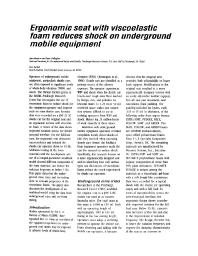 |
Operators of underground mobile equipment, particularly shuttle cars, are often exposed to significant levels of whole-body vibration (WBV) and shock. The Human Factors group at the NIOSH-Pittsburgh Research Center has investigated the use of viscoelastic foam to reduce shock for the equipment operator and improve seats on mine shuttle cars. In-mine data were recorded on a JOY 21 SC shuttle car for the original seat and an ergonomic version with viscoelastic foam. A review of the data shows improved isolation across the driver/seat pad interface. For the full-load case, the ergonomic seat decreased transmissibility and isolated the shuttle car operator down to 15 Hz. Additional testing of the foam materials with the development and use of a lumped-parameter analytical model showed different composites of the foam materials can reduce the isolation frequency to below 5 Hz. This paper describes the underground mine trials and the testing done to evaluate properties of the viscoelastic foams. The paper also discusses the development of an analytical model using the data from underground trials and the foam testing.
| Author(s): | Mayton-AG, Gallagher-S, Merkel-R |
| Reference: | In: B. Das; W. Karwoski, eds., Advances in Occupational Ergonomics and Safety II, IOS Press and Ohmsha, 1997 Jun; :177-180 |
eswv (PDF, 157 KB)